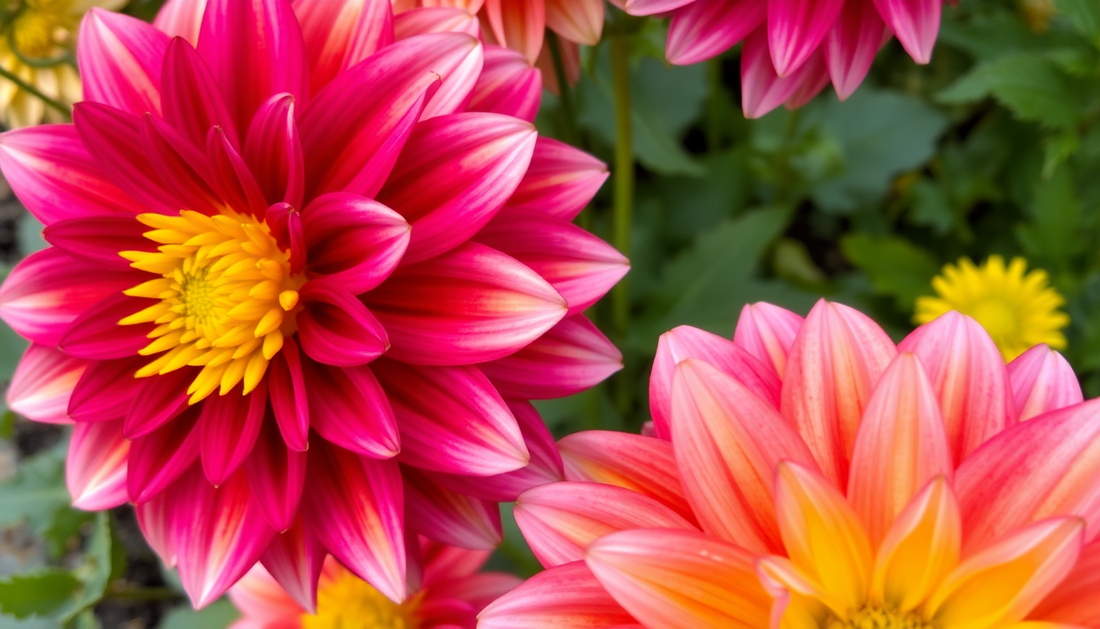
Why Are My Dahlias Turning Yellow?
As a passionate gardener, I know the frustration of seeing your beloved dahlias start to turn yellow. It's a common issue that can have a variety of underlying causes, from nutrient deficiencies to pests and diseases. In this comprehensive blog post, we'll explore the reasons behind yellowing dahlia leaves and provide you with practical solutions to keep your plants healthy and vibrant.
Understanding Dahlia Foliage
Dahlias are known for their stunning, vibrant blooms, but their foliage is just as important. Healthy dahlia leaves should be a deep, rich green color. When the leaves start to turn yellow, it's a sign that something is amiss in the plant's environment or care.
Nutrient Deficiencies
One of the most common causes of yellowing dahlia leaves is a nutrient deficiency. Dahlias are heavy feeders and require a balanced diet of essential nutrients to thrive. If the soil is lacking in key elements like nitrogen, phosphorus, or potassium, the plant will struggle to produce chlorophyll, leading to yellowing leaves.
To address nutrient deficiencies, start by testing your soil to determine which nutrients are in short supply. Then, apply a high-quality, balanced fertilizer formulated for dahlias, following the instructions on the package. You can also supplement with specific nutrient-rich amendments, such as compost or bone meal, to address any imbalances.
Overwatering or Underwatering
Improper watering can also lead to yellowing dahlia leaves. Both overwatering and underwatering can stress the plant and cause the foliage to turn yellow.
If the leaves are yellowing and the soil is consistently moist, you may be overwatering your dahlias. Reduce the frequency of watering and ensure the soil has a chance to dry out slightly between each application.
On the other hand, if the leaves are yellowing and the soil is dry, the plant is likely underwatered. Increase the frequency and amount of water you provide, being careful not to overcompensate and cause waterlogging.
Pests and Diseases
Pests and diseases can also contribute to yellowing dahlia leaves. Common culprits include aphids, spider mites, and fungal infections like powdery mildew or botrytis.
Carefully inspect your plants for signs of pest infestations or disease, such as webbing, discoloration, or spots on the leaves. If you identify any issues, take immediate action to treat the problem, whether it's applying an organic pest control solution or using a targeted fungicide.
Environmental Stress
Dahlias are sensitive to environmental stressors, and these can also lead to yellowing leaves. Factors like excessive heat, cold, or direct sunlight can all cause the foliage to turn yellow as the plant struggles to cope with the unfavorable conditions.
To mitigate environmental stress, consider providing your dahlias with some shade during the hottest parts of the day, or moving them to a more sheltered location if they're exposed to harsh winds or cold temperatures.
Reviving Yellowing Dahlias
If your dahlias are already showing signs of yellowing leaves, don't despair. There are several steps you can take to revive your plants and restore their vibrant foliage.
Pruning and Deadheading
Start by carefully pruning any severely damaged or yellowing leaves. This will help the plant redirect its energy to healthy growth and prevent the spread of any underlying issues.
While you're at it, be sure to deadhead any spent blooms. This will encourage the plant to focus its resources on producing new, healthy foliage and flowers.
Fertilizing and Watering
As mentioned earlier, addressing any nutrient deficiencies or watering issues is crucial for reviving yellowing dahlias. Apply a balanced, dahlia-specific fertilizer and adjust your watering routine as needed.
If you suspect a specific nutrient deficiency, you can also use a targeted supplement, such as a foliar spray or soil amendment, to address the problem.
Pest and Disease Control
If pests or diseases are the culprit, take immediate action to eliminate the problem. Use organic or natural pest control methods, such as neem oil or insecticidal soap, and apply any necessary fungicides according to the manufacturer's instructions.
Be sure to monitor your plants closely and continue treating the issue until the yellowing leaves have been replaced by healthy, vibrant foliage.
Preventing Future Yellowing
To keep your dahlias healthy and prevent future yellowing, focus on providing them with the optimal growing conditions and care.
Soil Preparation
Start by ensuring your soil is well-draining and rich in organic matter. Amend the soil with compost or other organic materials before planting your dahlias to create the perfect growing medium.
Proper Planting and Spacing
When planting your dahlias, be sure to follow the recommended depth and spacing guidelines. This will help the plants establish strong root systems and prevent overcrowding, which can lead to various issues.
Consistent Watering and Feeding
Establish a consistent watering and fertilizing routine to keep your dahlias well-nourished and hydrated. Adjust your approach as needed based on weather conditions and the plant's growth stage.
Pest and Disease Monitoring
Regularly inspect your dahlias for signs of pests or diseases, and take proactive measures to address any issues before they escalate. This may include using organic pest control methods or applying preventative fungicides.
Proper Sunlight and Temperature
Ensure your dahlias are planted in a location that provides the appropriate amount of sunlight and is sheltered from extreme temperatures. Adjust their placement as needed to optimize their growing conditions.
By following these best practices, you can help your dahlias thrive and prevent the frustrating issue of yellowing leaves. With a little care and attention, you'll be rewarded with a stunning display of vibrant, healthy blooms all season long.







No comments